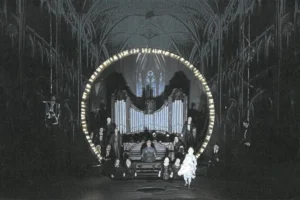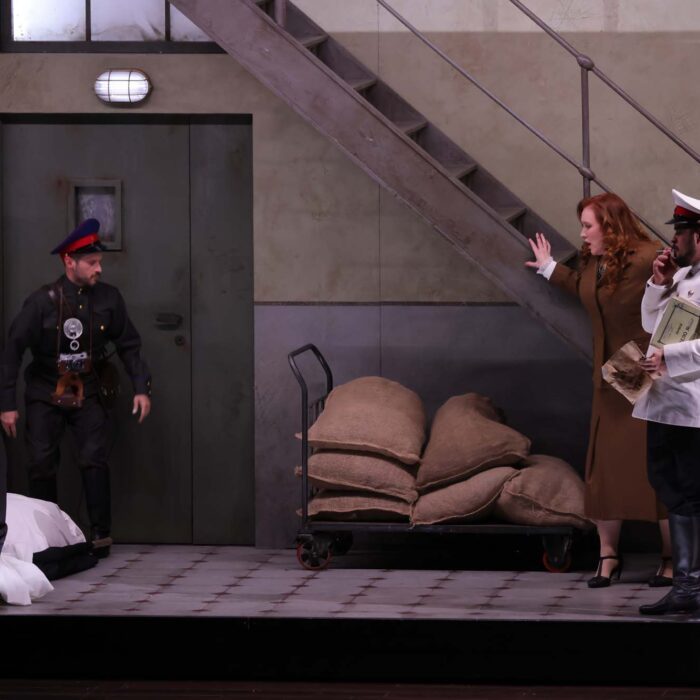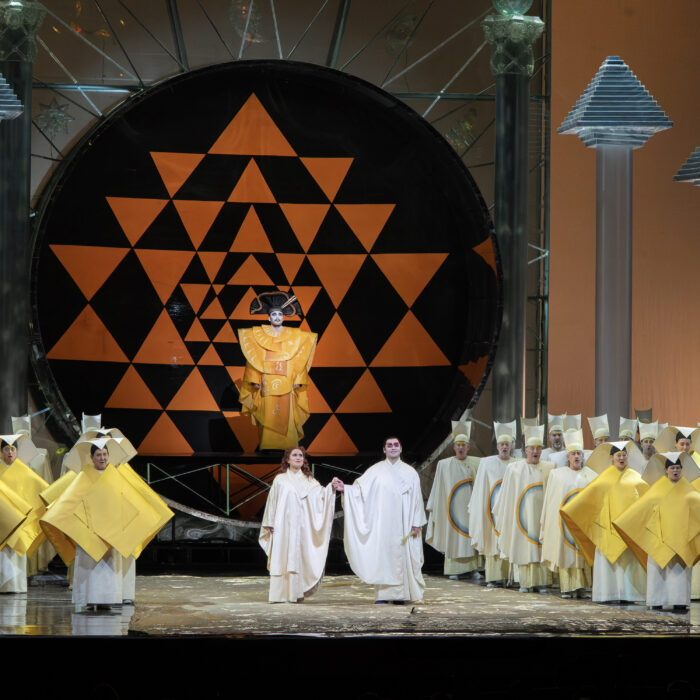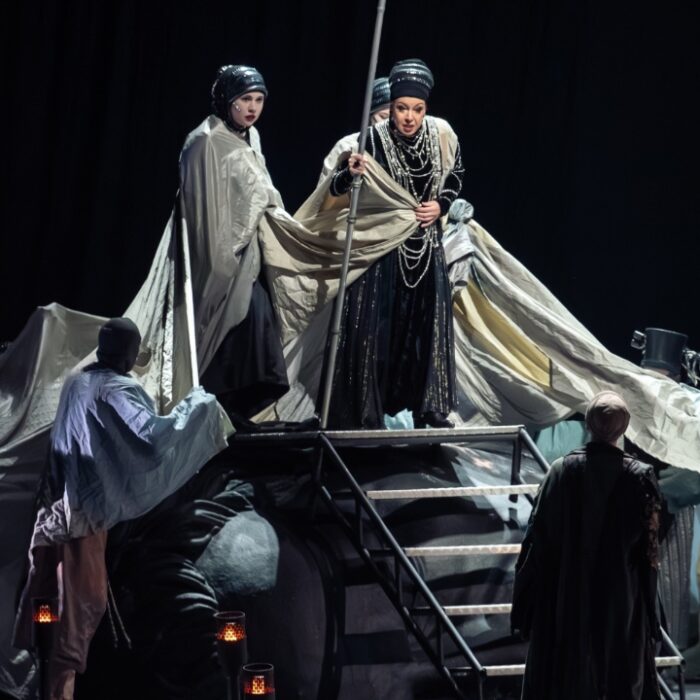
Palau de Les Arts 2025-26 Review: Faust
By Mauricio Villa(Image source: Official Les Arts Website)
Palau de Les Arts opened its 2025-26 season with a brand-new production of “Faust,” coproduced with La Scala de Milán, Staatsoper Unter den Linden Berlin, and Teatro Real Madrid. Les Arts continues to maintain a classical repertoire. Despite being a young institution, which opened just 20 years ago, it is the second time that Gounod’s masterpiece has been performed at the Valencia Opera House.
The new production signed by Stage Director Johannes Erath, whose production of “Les Contes d’Hoffmann” was seen in Valencia in 2022, was a senseless cacophony of parallel dramaturgy that made the plot both confusing and entirely unoriginal. One could categorically list all the past productions where Erath’s supposedly original ideas were actually seen for the first time, but it would be pointless and unnecessary. Among the all too familiar elements was the decision to use a circus aesthetic, including characters dressed as clowns; introducing us to an incongruously young Faust; Marthe appearing dressed as a nun; and Mephistopheles playing the organ while dressed as a ranking member of the Catholic church. Not only did I have the feeling that there was nothing new in what I was seeing, it made Gounod’s story incomprehensible. For example, I would like to know why such a heroic character as Valentin, a soldier who defends his sister’s honour to the death, is presented as a circus clown with a white balloon wearing a ridiculous blond Prince Charming wig — and one wonders how the singer felt while performing this role in that costume.
There is one crucial matter where Erath’s “modern concept” fundamentally lets the audience and the story down. Faust is depicted as young from the very beginning — something that has been extensively done in recent years — which completely undoes the principal conflict of the story. Faust is an old doctor who is going to commit suicide because he considers that he has wasted his life and youth studying, researching, and experimenting, and has not enjoyed the pleasures of life. He sells his soul to the devil to be young again. This singular idea is what causes the actions, reactions, and tribulations of the entire opera. If Faust is young from the very start the whole story just does not make sense.
I have little more to add. Erath’s staging was confusing, bordering upon the absurd at times. Using ten dancers and actors to dance in the waltz scene while the choir were mostly static proves the director’s inability to move the choir and find an easy solution. The famously bombastic “soldier’s choir” — “Gloire immortelle” — was presented with the choir completely stationary behind a transparent cloth onto which shadow imagery was projected. It is sadly very common today for directors to use dancers when they do not know what to do with the choir. But what seemed completely ridiculous was to stage the long ballet scene with the opera’s characters, rather than using the dancers. Would it not be logical to use the dancers for the ballet scene? The audience showed their discontent during the curtain call by booing the artistic team. Conversely, for all the failings of the staging and artistic direction, the performers were excellent.
Tenor Iván Ayón-Rivas portrayed the titular role. The performance of this artist was just remarkable. He is an incredible singer. He possesses a truly lyric tenor voice which grows in volume and projection as it rises up in his range, a beautiful natural squillo and fluid fraseo with long legato lines. His low register was strong enough to sing the baritonal tessitura of Act One. His singing was infused by a constant contrast of dynamics. He sang his first soaring diminuendo in the F sharp of “Dieu” — a difficult note in the passagio zone to sing a diminuendo — in the first act. His ability to sing diminuendo goes up to B natural in the “Kermese” scene, and the high C at the end of his aria “Salut demeure chaste et pure.” Very few tenors dare to sing a diminuendo in a high C, especially if we consider that his middle to high register has a strong projection and beautiful squillo. The attack of the high C was so strong and secure that I wished he would have held the note en forte longer, if only to continue to enjoy such a top ringing powerful note. His voice, and his high B flats, were above the other singers during the Act Four trio. He sang the “invocation of Mephistopheles” with a believable dramatism and strength, delivering a strong ringing Ab in “A moi.” This verismo approach was in huge contrast with the beautiful legato lines of his first encounter with Marguerite, “Ah! Ne me permetez vouz pas,” his famous aria, “Salut! Demeure chaste et pure,” or the love duet, “Laisse moi!” If Ayón-Rivas can ensure his career navigates the correct repertoire without overworking — two factors that can destroy voices — I am sure he will rise up to be one the top ten tenors. It is difficult to find such good singing and strong technique in young singers today.
Bass-baritone Alex Esposito shined as Mephistopheles. He was the most recognized artist of the night, receiving the largest ovation. You could not tell if he was a singer who acts or an actor who sings. His detailed and complete personification of the devil Mephistopheles was sarcastic, monstrous, and very convincing. He has a dark timbre with a naturally balanced vibrato and modest volume. His lower register is weak, and his voice projection is modest, but he made up for it with an amazing performance. Every single line he sings has intention and a different color. It therefore offered impeccable interpretations of his arias “Le veau d’or” and “Vous qui fate l’endormie.” His stage presence is hypnotic and magnetic. He really stole the show, which was a relief as it made you forget the constant nonsense coming out of the staging occurring around him.
Soprano Ruth Iniesta was Marguerite. This role is written for a pure lyrical soprano while Iniesta is a lyrico-leggera. It is true that her timbre is dark and that the voice has big volume, but she could not achieve all the vocal demands of this role. The second and third acts have light orchestration when the soprano is singing. Consequently, the soprano’s voice was present and her bel canto technique showed in perfect trills and staccato notes in the “jewels aria,” as well as in the Act Two love duet with Faust. Her high notes were secure, although her marked vibrato made the sound strident — B natural in the aria and two high Cs in the duet. Yet, though her high notes may have had great volume, her high C en forte at the end of the act was hidden completely by the orchestra and Mephistopheles’ laughter. The problems became apparent in Acts Four and Five. The “spinning wheel” aria in Act Four also has light orchestration but the aria demands a deep sorrow and dramatism that the soprano’s voice did not achieve. This was even more noticeable in the church scene, Valentin’s death, and the final prison scene. Her voice just could not sustain the dramatism required. In the final trio the voice of the tenor was heard clearly over the soprano, the bass, and the orchestra en forte, and he projected a high B natural, hiding the same note sang by the soprano.
Baritone Florian Sempey sang a lyric Valentin with expansive long lines in his entrance aria, “Avant de quitter ce lieux.” He has an easy and effortless high register — as he proved in the attack of the multiple high Gs of the aforementioned aria — and exquisite French style. His voice projection and volume were modest and his voice melted into the ensemble during the scene with the choir in Act Two, sounding small and distant. It happened again during the “Duel trio” in Act Four. It is a pity that he had to defend such a nonsense characterization with such a ridiculous costume, but he was energetic, believable — if ever there was some truth in the director’s concept — and performed a moving and dramatic death scene.
If one would describe Conductor Lorenzo Viotti’s work in a single word, it would be “contrast.” He opted for extreme tempi, from slow and pesante (as in the overture) to extremely fast and lively (as in the Act Two waltz). The whole performance was a constant rollercoaster of tempi, attacked with determination and intention by the orchestra creating a solid and meaningful musical language and making Gounod’s score alive, strong, and entertaining. The love duet in Act Three was another example of extreme pesante confronting extremely fast tempi. Considering that there are several versions of the score — including a German one named “Margarete” with plenty of extra music for the final prison scene not traditionally used — he presented its’ most complete version, using the Alkor Edition. Often this score is drastically cut to make the opera shorter, but Viotti gave us all the music and arias in the scene in “Margerite’s room” in Act Four — a scene that is usually removed completely — and nearly complete ballet music. The orchestra played well, even the unusual musical coda at the very end of the opera at the final “Apotheosis.” Viotti did cut — as far as I could tell — all the popular interpolated notes like the high F in Mephistopheles’ entrance; the end “in alt” in Valentin’s aria (resolving down as written); and the first B natural of the tenor during the final trio in Act Five (presenting the score as Gounod had written it). He managed to control the balance of the two different melodies presented in the waltz scene in Act One, the choir and the orchestra being in perfect communion. The Orquesta de la Comunitat Valenciana and Cor de la Generalitat Valencia were splendid.
Les Arts presented for the second time in its short history Gounod’s masterpiece “Faust,” with an all-new production under the ardent and brilliant baton of Lorenzo Viotti where the two male leads, sang by Iván Ayón-Rivas and Alex Esposito, stole the show with their beautiful voices, secure technique, perfect French style, and meaningful interpretation.


